Insane Stunt Car Antics: Trackmania Nations
While I will usually focus on smaller independent productions, there are certainly some fully-funded retail productions that deserve mention. The Trackmania series of games definitely stands out from your typical racing game. Driving games are inherently physics-games. They obviously mimic a very physical activity. Some racing titles focus on perfect simulation, others mix in idealized controls (FlatOut comes to mind), and still others do away with realism altogether (why haven’t they made a new Carmaggedon game?).
Trackmania Nations stands somewhere between idealized and absurd. It’s almost best to think of the game as a platform game, but instead of Mario you have a speedy little car. The courses range from the expected, very typical race tracks to outright insane loops, half-pipes, and boost-powered jumps. This Flash 8 video shows off one of the advanced courses:
Best of all, Trackmania Nations is free. It’s a downloadable release specifically created for the Electronic Sports World Cup. Players will be able to train for finals to be held in Paris this summer. Apparently there’s $400,000 up for grabs. Personally, I don’t have the aptitude to hone my driving skills to a competitive level, although I certainly appreciate the free gameplay.
The game contains 90 solo training tracks ranging from the very simple to the nearly gimmicky. Some of the expert tracks require you to use jumps and other props in very nonstandard ways. The earlier levels train you in on how to use props in a certain way and then they pull the rug out from under you. If you get tired of the existing tracks the game includes an editor; all of the included tracks were made with it. Want to string three crazy loops together with a bunch of boosts? Go for it.
Trackmania Nations is more about optimizing for time than it is exploring crazy physics courses. Some aspects of the game are frustrating and require a lot of trial and error. For instance, it’s difficult to judge how fast you should be going on certain jumps without having failed at least once or twice by over- and under-shooting. Analog controls like a PS2-style joystick or driving wheel will certainly give you an edge over the keyboard controls. It’s much easier to modulate your speed on a smooth basis when it comes to the later, more difficult levels.
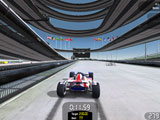
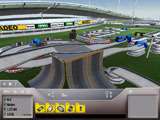
(Trackmania Nations Game Screenshots)
The game is available free as a rather large download (265 MB). Be warned, though, it does require you accept Starforce protection in order to play it. I suppose that’s there to protect the game from hacking on account of the whole competing-for-real-money thing, but if you’ve had trouble with Starforce in the past you may want to take a pass on this one.
Trackmania Nations is a very neat slant on the driving genre. Why race in a flat circle when you can zip through imagination courses at several hundred miles per hour? It’s a fun way to kill a few hours, and you can’t beat its value at the low, low price of absolutely free!
Download Trackmania Nations here (265 MB).
Related Posts:
Block-Stacking Fun: Solid Balance
Solid Balance is a stacking physics game by Solid Games. It’s a physics game that replicates something we all probably did in our childhood: stack boxes. The goal of each level is to stack an ever-increasing number of boxes and other objects without tipping everything over.
The game has two modes. The default mode has no restrictions. You simply place whatever object is next in line. The problem with this is that there is very rarely a compelling reason to do anything except place in the center and symmetrically. Inertia from the object you are currently placing will transfer over, though, so a soft touch is essential.
Far more interesting is the “color rule” option. With this option turned on, another failure state is added. If two objects of the same color touch you will lose. This is much more interesting. You quickly learn to leave pockets in your tower to place unwanted objects and need to think on your feet when you get two large pieces of the same color. The game shows you the next two upcoming pieces to help you plan ahead. You don’t have long, though; there is a time meter that counts down. Whatever piece you’re currently placing will drop when the time meter empties.
Solid Balance uses the TOKAMAK physics engine which has specific optimizations for stacking. Even so, sometimes the behavior of the blocks is a little weird. They tend to skate around a bit before coming to a rest. They come to a rest very quickly, too, which is both good and bad. It provides a stable base, but it’s also hard to see an impending collapse coming. When your tower shifts it tends to destabilize very quickly. It would be nice to have more advance warning in order to have the chance to balance things out.
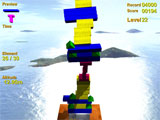
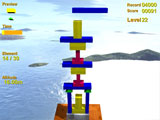
(Solid Balance Game Screenshots)
All told, Solid Balance is a good implementation of a stacking physics game. More variety would certainly be appreciated, but for roughly $10 USD the game delivers adequately at that price point. There is a 1-level demo available to try out the game before committing to a purchase. It’s relaxing fun and certainly much easier to clean up after than stacking real blocks.
Download Solid Balance game here (5.09 MB) or head on over to the Solid Balance page at Solid Games’ website.
Related Posts:
- Drunken Ragdolls Fight for Our Amusement
- List of Physics Games
- Smashingly Fun Vehicle Physics with FlatOut 2
- I Hate Clowns (Web Version)
- Excellent Marble Madness-Inspired Physics Game
Classic Physics Game: Stair Dismount
Stair Dismount, also known as Porrasturvat, was one of the first ragdoll games to see massive viral propagation. It was just one of those games that you had to paste to your friends. The premise is simple: a ragdoll man is standing unaware at the top of some stairs. As the player you select which limb to hit, the angle, and time the "dismount" to coincide with a fluctuating power meter. As the ragdoll tumbles down the stairs the damage to each limb is tallied. Local and online high score lists show how you stack up against your best records and other players.
There is an addictive element to Stair Dismount‘s simplicity. It’s hard to resist the temptation to fiddle with the angles and power for subsequent attempts. Could you deal more damage with a weaker hit and thus a longer fall? Is it better to slide down the stairs or get the ragdoll tumbling head over heels? I’d be surprised if anyone could play the game just once without playing a second time to see if they could improve their score.
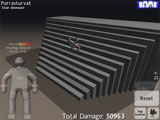
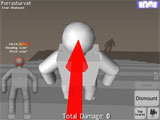
(Stair Dismount Game Screenshots)
Stair Dismount was developed by Jetro Lauha for the game development competition at Assembly in 2002 (it took first prize).
Download Stair Dismount game (2.20 MB) for Windows PC or head on over to the official website for Linux and Mac OS versions.
Related Posts:
- The Prequel to Hobo Dismount: Truck Dismount
- Pogoriffic Pogo Ponies: Pogo Sticker
- Walaber Experiments with Ragdolls and Aerial Skiing
- Physics-Based Beatdowns, Ragdoll Masters
- I Know Rag Fu: Ragdoll Matrix Reloaded


 (Rate this game! 449 votes, average: 4.11 out of 5)
(Rate this game! 449 votes, average: 4.11 out of 5)
 My name is Matthew Wegner, and this site is dedicated to physics games.
My name is Matthew Wegner, and this site is dedicated to physics games.